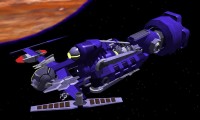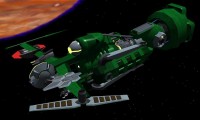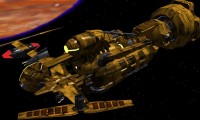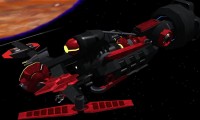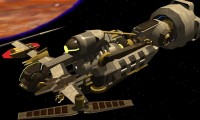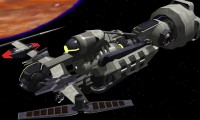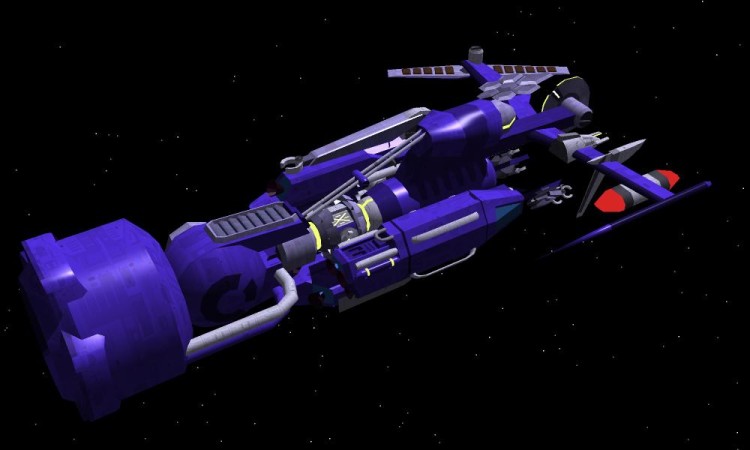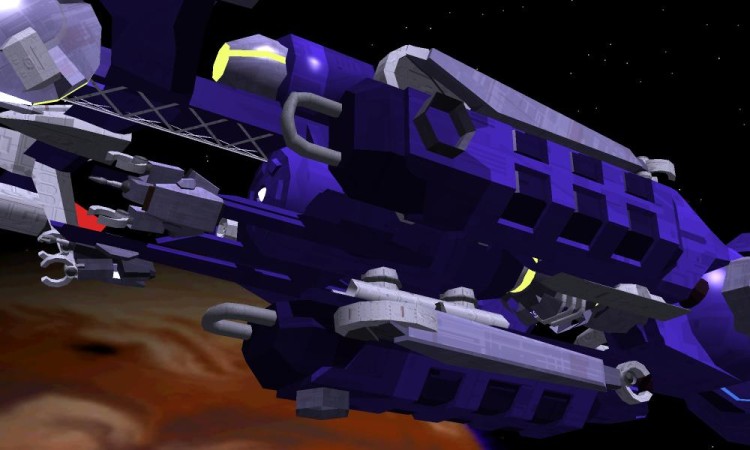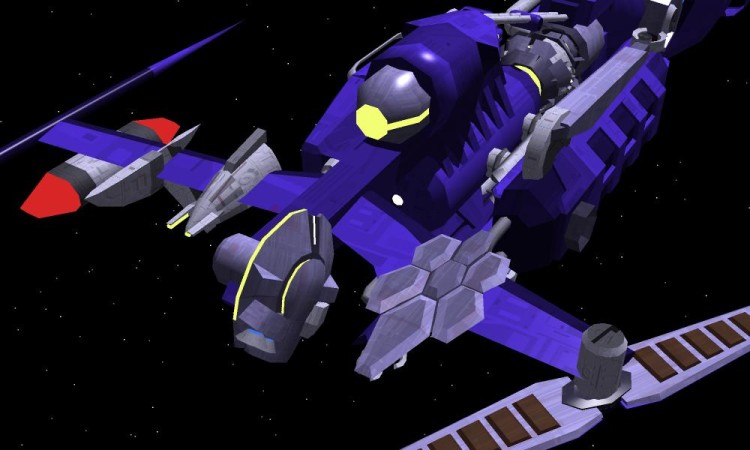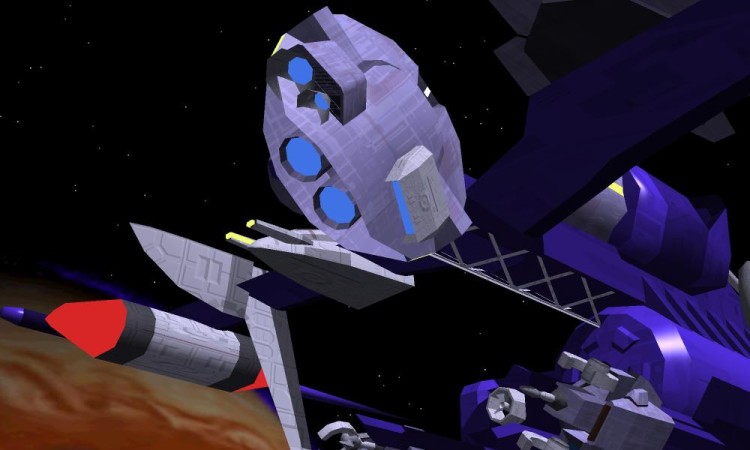Sidebar
Table of Contents
Eye-III Class Stealth Corvette
Small, fast stealth corvettes designed for long range sensory support, stellar cartography, stellar prospecting, and first contact missions, based on lessons learned reproducing a ship found in orbit over Planet Osman. They were added to the IIS production roster in late YE 40 with a larger production run. It was based off the Eye-II Class Stealth Corvette.
They were adopted by the Star Army of Yamatai at the approval of the Star Army Research Administration's Acquisitions Division in YE 42. The Eye-Class of vessels saw massive popularity in Star Army Reconnaissance. For the Far Line and Garrison Regiments, they are utilised as inexpensive but effective sensor suites to alert to incoming vessels. For the Unconventional Regiment, the ability to utilise the additional crew pods to coverty insert their members to occupied planets was seen as a great boon.
After Star Army Special Operations was formed, the Eye-Class of vessels were instantly adopted and used for the same reasons as the Rangers. Especially, Target Neutralisation Outfit teams saw this as a very interesting prospect.
Prototype pictured in main faction colors and unpainted.
Star Army of Yamatai blue
Democratic Imperium of Nepleslia Green
Classic Bronze
New Dusk Conclave black/Red
Kingdom of Neshaten tan
Unplated, no paint.
History and Background
Surprised by the success of the Eye II Stealth Corvette, IIS aimed to improve reliability, utility, and survivability of the craft by adding several self repair systems and improving the existing sensor platform. This was combined with swarming collaborative AI technology pioneered by the Mercian class autonomous fabricators and Freespacer Junkers, producing a new series of small sized minimalist stealth scout ships designed to be more rugged without sacrificing the signature speed and powerful sensors of the original. While the mechanical overhaul of the design was extensive, the most major change was, in fact, the software.
About the Ship
Based on the design of the “Eye in the Sky” scout ship discovered at Osman System in YE 39,
The design choice was obvious for a person who would find a 10×10 prison cell luxurious, though a bit cramped for most pilots. Bare minimum, fast, with powerful sensors and engines on minimum viable power and computer systems. Unfortunately, with bare minimum in all defensive systems, anyone who didn't like her presence could easily shoot her down. Thusly, the original designer1) decided to add in the best stealth systems she could find, and develop some of her own based on existing technology and parts found on derelicts and in scrapyards. These made it into the Eye II class alongside some of IIS's own proprietary systems.
The result was little more than a manned probe, classified as a long range scout corvette.
Key Features
The ship is capable of gathering massive amounts of data in a short period of time, and is “biphasic” or of a two phase design.
When the pilot arrives at a contracted research planet, the satellite settles in to a stable orbit (Usually geosynchronous) and jettisons its pods. The cargo pod follows the living pod closely as it defrosts the pilot and enters the atmosphere. When the research is complete, all pods can make orbital escape and be collected by the satellite core. Raw data is processed on board and en route to home orbiting stations, where the ship docks as one piece for repairs and modifications as needed for the next mission.
This ship boasts some of the highest sensor power to size ratios in the Kikyo Sector. It also boasts maneuvering and raw acceleration capabilities well outside the capacity of many starfighters' performance threshold, if it holds together under the tortioning forces, and as long as the inertial dampers aren't damaged. Due to being powered by a fusion bottle reactor one might find on a midbulk transport, the ship has enormous power reserves, with fifty percent of base power capable of routing to sensors, or jumping at a mere 70% throttle.
Mission Specialization
The modular nature of these ships allows for a wide variety of missions, however two factors will always remain the same on any ship bearing the Eye in the Sky model name.
- Stealth and Observation: Molecular scanning and technical scanning ability to produce high resolution images and detail down to blueprints
- Rapid Deployment/Movement: Max acceleration allowing zero to .55c in 25 seconds and low profile prevents targets lock and allows rapid escape.
Appearance
Pretty is not how one would describe this particular awkward bird. The reactor is exposed to space, an angry glow and offgasses marking its position far better than any anti-collision lighting, which the ship does not have. The view from the rear is obscured by the single massive cruiser's main engine fed directly off of the reactor's waste power. The hyperspace fold drive is visible and exposed to open space, sitting dangerously close to the cockpit and mounted just aft of the primary sensor core and a fourteen petabyte hard drive. Two winglets mounted either side of the hull balance the vertical profile with a set of sensor nacelles from the front, and curve outward to encompass the forward hull and obscure the pod mounts.
There is a layer of organic growth over the entire frame, which is actually a silicon based photosynthetic skin that assists with structural integrity and uses specialized chromatophores to scatter radar, infrared, and X-ray imaging to obscure its image or prevent a target lock. Other stealth systems on board are less visible, but its comm firewall masks the comm behind background radiation in local area, preventing interception by prying eyes.
Statistics and Performance
Most starships in setting use basic statistics to display certain values. The Eye series is unique in that it is still subject to Newton's Third Law, and is thus reliant on thrust to weight ratios.
General
General statistics and performance used to loosely define the ship for registration, hull numbering, and titling purposes.
- Class: Scout interceptor (Loose technicality)
- Type: Unarmed research vessel
- Designers: IIS technical teams
- Manufacturer: Iemochi Innovations & Sales
- Fielded by: Multiple buyers
- Nomenclature number (Model no.): IIS-Y1-3a
- Price: 40,000 KS (Base2) ) 48,000KS for base model with sensors and skin.
Passengers
Crew and passengers are minimal at best, the original Oracle having once carried a passenger inside its cargo pod. The Eye IIs currently utilized by Bravo Prototype Force are equipped with excess personnel pods to solve this problem.
Crew: 1
Maximum Capacity: 3 (When equipped with two extra personnel pods)
Options
All options replace the standard 2m3 cargo pod
- Mosquito Gun Pod (10,000 KS +Ammo cost)
Cargo pod with attached 50mm railgun. Starfire, standard kinetic, probe, or orbital bombardment ammunitions optional. Also includes a sensor tie-in and computer based targeting compensator.
- Secondary Personnel pod (13,000 KS)
Secondary reentry fitted cryogenic pod for personnel transport
- Oversize cargo pod (1,500 KS)
Cargo pod of larger internal volume at cost of stealth, internal volume 3.5m3
- Enhanced sensor package (14,000 KS)
Sensor system controller and booster package, increases detection ranges and scan detail
- CDD/Fuel module (12,000 KS)
30 liters of extra deuterium for reactor fuel and a micronized continuum distortion drive rated at 12 AU/Sec
Systems extras
- Aether-plasma inline thruster
Delivers the same performance whilst negating engine power requirements (2,000 KS)
- Aether reactor
More power is more better! 50% better power without requiring fuel! (Negates passive thermal stealth system) (5,000 KS)
Skin Color
Due to improvements on the gene sequencing on the chromatophoric bioskin, the Eye III is available in any color, from Star Army Blue to IGN Green or hi-vis white.
Dimensions
These ships are small, too small to be used as long term homes, however, they have to be large enough to support the engine and sensor systems.
- Length: 8 meters (26 feet)
- Width: 4 meters (13 feet)
- Height: 4 meters (13 feet)
- Decks: 0
- Mass: 3.62 tons (Metric)
Propulsion and Range
Eye in the Sky class starships have bare minimum viable systems, and are thus, rather high maintenence, requiring constant refits and repairs. They has an open body hull with exposed support beams to save weight, and the habitable compartment is absolute bare minimum viable. Well below “Humane” limits for manned space flight.
- Hyperspace Fold Drive: 75 LY/hr
- Sublight Engines: Single engine, plasma rotor, top speed attained in 25 seconds, top speed of .45c (.55 depending on GM)
- Max Thrust: 672317.43 G (Based on accelerating to 55% of lightspeed in 25 seconds)
- Range: 1,000 light years single jump
- Lifespan: Unknown (Constant refits and mods)
- Refit Cycle: 6 months (Or four jumps, as the ship tends to tear itself apart every 4-5 jumps)
Damage Capacity
See Damage Rating (Version 3) for an explanation of the damage system.
DR-3 ratings
- Hull: T6 Unarmored
- Armor: Unarmored(Open hull design, armor nonexistant.)
- Barrier: Tier 6 forward -2 (Standard space flight electromagnetic/inertial damping barrier, not rated for beam or kinetic weapons of any kind.) (Secondary barrier of Tier six front facing cascade, deflector shield.)
Vehicle offers no ballistic or energy weapon protection, relying on sheer speed and small size to avoid fire, combined with stealth systems to prevent target lock.
Inside the Ship
Honestly, there's not much to the inside of an Eye class vessel. The ship is, after all, mostly engines and sensors, almost like crew comfort was a mere afterthought.
Deck Layout
Cryo pod stuck to the top. No other livable space. Livable volume 5'X2.5'X2.5'
Compartment Layouts
Compartments are achieved by external modules. The ship comes standard with two cargo pods and one personnel pod.
Bridge
Single crew compartment.
The crew compartment is a single cryogenic stasis pod, modified to act as a short term living space for the occupant. Above the head is a cabinet to store an EVA suit or a change of clothes, a few ration bars, and some books for light reading while waiting for data to compile. There is an IV feed near the left side, pumping a sugar and nutrient blend, replenished via filtering water from the suit waste disposal system. Control is via a touchscreen interface on the forward glass panel of the cockpit and two joysticks deployable from the side walls of the pod.
Cargo Storage Areas
Cargo Pod (2)
A simple reentry capable cargo pod with a follow mode on a beacon attached to the outside of the crew pod. Simple RCS giudance and soft landing thrusters and an internal volume of 2 cubic meters.
Junker Containment Module (2)
A small hull mounted pod that holds one Junker for field repair and maintenence of the host ship.
Picojelly Containment Module
A hull mounted two liter container of Metal type Pico-Jelly used for fast self repair
Ship Systems
Minimalist at best, dangerous at worst, Eye class vessels embrace and idealize minimum viable.
Armored Hull and Hull Integrated Systems
Tier 6 unarmored
Open hull design with systems exposed to space. Minimum viable to the point of not even having a proper hull.
Computers and Electronics
Single “dumb” AI primary computer control system, with data collection and storage of up to 14 petabytes. This system is linked into a hive mind functionality that allows datasharing and system control across multiple similar craft, compatible with IIS' Dawn AI or similar.
Junker control module allows control of two ship integrated Junkers and a tube of Picojelly for field repairs.
Standard communications array uses a high power beacon style subspace radio and a noisemaker to mask the signal. It can also use the laser diode from the laser spectrographic sensor as a low quality laser communications signal, and can use the noncollinear sensor as a radio transmitter to produce a UHV/VHF video radio signal.
Software Package 1.0
The key feature of this software package is a user friendly HUD that ties in ship controls and data feeds to the single plateglass screen of the canopy window. It also features a developer mode that allows users to build software packages that will augment or specialize ship abilities with minimal reference whilst protecting IIS proprietary operating system technology.
- Virtual Sensor Package gives the ship the ability to simulate certain sensor platforms not actually on board to improve scan detail or take various simulated scans.
- System Maintenence Drone Control Subsystem (SMDCS) automatically detects hardware faults and directs Pico-Jelly and Junker repairs in flight.
- Adaptive Chromatophore System modulates the chromatophoric overskin to mimic background with unparalleled clarity by cross referencing sensor feeds.
- HFD AI Modulator is designed to modulate the field of the hyperspace fold drive, maximizing efficiency and minimizing hotspot flares responsible for a large or easily tracked jump.
- SafeBurn V3.7 is a simple engine control plugin, digitally limiting the engine's maximum burn rate via the performance of the inertial damper.
Emergency Systems
One distress beacon, automated and powered by an RTG rated at 200 years (See Hyperspace Radio Beacon under Computers and Electronics)
Cryogenic emergency life support able to keep one Minkan or Nepleslian under cryogenic suspension for 110 standard years.
Life Support Systems
Nutrient feed line via permanent set IV for pilots, chemical/biological rebreather system with photosynthetic oxygen production.
Propulsion
Single main plasma rotor engine and fuel system.
Single hyperspace fold drive with integrated inertial damper
Optional inline Turbo Aether Plasma Drive engine. Same thrust, eliminates stealth systems functionality. 5) (Costs 2,000 KS extra)
Barrier Systems
The Eye III-Class has a Standard geomagnetic shield rated for heavy duty operation in extreme radiation deep space environments and a single forward facing Type 36) barrier system for repelling oncoming debris. No other shielding systems.
Power Systems
Single Tokomac7) fusion bottle, unshielded, with thermo/radiovoltaic collector. Output rating nearly four terawatts per second. Fuel preheater and mass based thermal seperator. Fuel is elemental deuterium with tritium spike.
Optional Aether reactor (Yamatai clients only due to production/distribution difficulties) (Costs 5,000 KS extra due to cooling system redesign)
Stealth Systems
Below is marked the stealth systems used by the Oracle, alongside intended effects and theoretical applications.
- Distributed fuel preheater Surface temperature of 105 degrees Kelvin, slightly below local space, rendering ship passively nondetectable on thermal imaging.
- Chromatophore overskin By using advanced biotechnology inspired skin, chromatophores render optical identification nearly impossible due to shifting patterns of shades of black and RADAR scattering properties. 8)
- Faraday cage over power systems Electron motion and EMF measurements near impossible due to EMF blocking properties of Faraday cages
- Tactics Uses nearby large bodies to hide mass, often by hiding near large asteroids or nearby ships
- Kaleidoscopic quantum projector By projecting the quantum signature of gadolinium ore via from the noncollinear sensor array, it masks its own quantum mirror signature behind what appears to be a mass of ore.
Sensor systems
Below is marked the basic sensor clusters of the Eye III class without regard to their location on the hull, which can be found in Appearance.
- 220,000 element noncolinear phased array (variable wavelength transceiver)
A combined magnetic resonance, electron motion, and radar array with active scan functionality. Also functions as a radio telescope. Also helpful in projecting a supposed quantum event or state.
- Geomagnetic sensor cluster
A series of hall effect and electric field sensors designed to detect and evaluate magnetic fields, usually planetary, but useful in detecting and evaluating another ship's barrier system.
- six Quantum Mirror sensor cluster
Used to determine quantum events such as hyperspace fold or continuum distortion jumps.
- Penetrating Radar
Can penetrate a ferrium hull up to two hundred meters and determine decks and equipment placement, originally designed for locating geology under foliage from orbit and mapping near surface cave systems.
- Laser spectrograph
Simple laser spectrograph used to determine surface composition of an object.
- Scalar gravitational field sensor
Simple mass sensor, useful in determining where something is and how much mass is there.
- Optical/X-Ray/Thermal camera array
Multiple cameras (Three optical, two X-Ray, and three thermal imaging) and software packages that allow optical image collection and correction for fluids, atmospheric effects, and high resolution at extreme range9)
- Gas sampler
Simple tube and chemical analysis unit used to determine the trace gas composition of nebulae or local space. Also allows sampling of asteroid belt dust.
- Subspace Antenna array
A heavy duty antenna operating in subspace to determine various quantum events and detect FTL communications and passing FTL vessels caused by the distortion of spacetime at the subspacial level used for subspace communications and effects of FTL systems. Unfortunately, can only detect the presence of a CDD field or subspace comms. It cannot hack into secured comms or gather useful data on the CDD system or ship using it.
Below is marked Virtual sensor systems achieved by combined effects and software packages.
- Phase-Band Radar
By combining radar properties of the hyperspace, subspace, and normal space antenna arrays across a software compensating platform, a virtual version of the Phase-Band radar system is possible.
- Laser rangefinder
By triangulating the known distance between the thermal imaging camera and the laser spectrograph, delay time, and reflection angle, the ship can detect its range to a target up to one AU away.
- Browning Motion Scanner
By measuring the flux in an otherwise stable magnetic field, one can plot the motion of electrons moving through three dimensional space. Eye series ships do this via AI calibration of the noncollinear array.
- Magnetic Resonance Imaging (MRI)
Similar to browning motion scanning, measures and images objects based on density. Achieved via AI calibration of the noncollinear array and geomagnetic sensors.
- Radar rangefinder/ Velocimeter
By plotting radar pulses and returns in by delay times to individual units in the noncollinear, can detect range and speed of an object via radar and software.
- Cutting Laser/light weapon system
OOC Notes
Madi Harper created this article on 2018/07/01 10:55.
Approved by Kyle Here
| Products & Items Database | |
|---|---|
| Product Categories | starships |
| Product Name | Eye-III Class Stealth Corvette |
| Nomenclature | IIS-Y1-3a |
| Manufacturer | Iemochi Innovations & Sales |
| Year Released | YE 41 |
| Price (KS) | 40.00 KS |
| Mass (kg) | 3,620 kg |
Page Tools
Terms of Service - Privacy Policy

